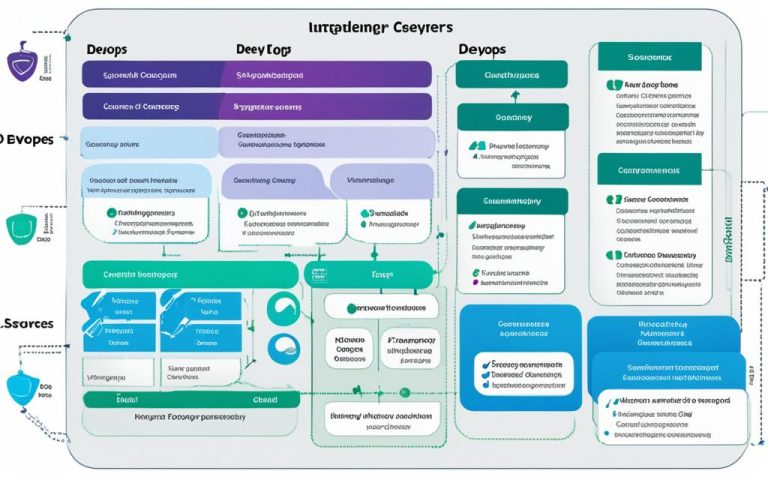Are you looking for efficient and cost-effective ways to manage your network in the cloud? Look no further! In this article, we will explore the best open-source cloud network management tools that can help you streamline your operations, improve visibility, and optimize performance. These tools offer a range of features and capabilities for network monitoring and management, all while being completely free resources.
Open-source tools provide organizations with better visibility and customization options for network management. They offer flexibility, affordability, and the ability to modify the code according to your specific needs. By leveraging open-source tools, you can avoid vendor lock-in and have more control over the product’s fate. However, it’s important to note that while these tools are free, they may have hidden costs and require trained staff for support.
In this article, we will discuss the benefits of choosing open-source tools for network management, how to select the right open-source network monitoring tool for your organization, and the best open-source network monitoring tools available in 2021. Let’s dive in and explore the world of open-source cloud network management tools!
Why Choose Open-Source Tools for Network Management?
Open-source tools offer organizations better visibility and customization options for network management. They provide the flexibility to view and modify the code, allowing developers to create plugins, incorporate community-driven features, and ensure continuous testing for stability and security. This level of customization sets open-source tools apart from their proprietary counterparts, making them an attractive choice for businesses seeking tailored solutions.
One of the main advantages of open-source tools is their affordability. Many open-source tools are freely available, providing enterprise-level features to smaller businesses and non-profit organizations without the budget for expensive proprietary solutions. This accessibility allows organizations to allocate their resources effectively and invest in other critical areas of their operations.
Moreover, open-source tools offer the advantage of control. Unlike proprietary tools that are dependent on vendor support, organizations utilizing open-source tools have the freedom to shape the product’s future according to their specific requirements. This level of control fosters innovation and allows businesses to adapt to evolving technology trends without relying on external vendors.
However, it is essential to be aware of the potential hidden costs associated with open-source tools. While the initial software may be free, organizations may incur expenses related to training staff to support and resolve any issues that may arise. It is crucial to assess and budget for these additional costs to ensure a smooth integration and ongoing support of the chosen open-source network management tool.
Open-source tools offer organizations better visibility, customization options, flexibility, and affordability for network management. Their ability to modify the code, availability of free resources, and control over the product’s fate make them an attractive choice for businesses seeking tailored solutions.
To illustrate the benefits of open-source tools further, let’s consider an example. Imagine a small non-profit organization that needs robust network management capabilities but has limited financial resources. By choosing an open-source tool, they can access enterprise-level features without incurring considerable expenses. They can customize the tool to meet their specific needs, ensuring a tailored solution while maintaining control over their network management strategy.
In conclusion, open-source tools provide organizations with the flexibility, affordability, and customization necessary for effective network management. By opting for open-source solutions, businesses can leverage the advantages of better visibility, continuous testing, and the ability to shape the product’s future. However, it is important for organizations to be aware of any potential hidden costs and invest in the necessary support and training to fully benefit from these tools.
The Benefits of Open-Source Tools for Network Management
Open-source tools offer organizations better visibility and customization options for network management. They provide flexibility for organizations that value customization over a “done for you” experience.
With open-source tools, network managers have the ability to view and modify the source code, allowing for extensive customization and tailoring to specific needs. This level of customization empowers organizations to optimize their network management processes and address unique requirements.
Additionally, open-source tools often come with a thriving community of developers and users who contribute to the software’s enhancement and improvement. This collaborative environment fosters continuous testing for stability and security, ensuring that the tools remain up-to-date and reliable.
One of the primary advantages of open-source tools is their affordability. Many open-source tools are available for free, enabling smaller businesses and non-profit organizations with limited budgets to access enterprise-level features without incurring significant costs.
However, it is important to note that while open-source tools may be free, there may be hidden costs associated with implementation, maintenance, and support. Organizations should consider factors such as training staff to effectively utilize the tools, ongoing support requirements, and potential integration costs with existing systems.
Another key benefit of open-source tools is the control they offer over the product’s fate. Organizations relying on proprietary software are often at the mercy of vendors for updates, bug fixes, and functionality improvements. In contrast, open-source tools allow organizations to take control of their network management infrastructure and make modifications as required, without being reliant on a specific vendor.
Example Quote:
“Open-source tools provide unparalleled visibility and customization options for network management. They empower organizations to fully tailor their network monitoring and control processes, delivering a level of flexibility that proprietary solutions often lack.” – John Anderson, Network Operations Manager at XYZ Corp.
When considering the adoption of open-source tools for network management, organizations should carefully evaluate the risks and rewards. It is essential to assess the specific needs and requirements of the organization, accounting for factors such as budget, expertise, and long-term goals.
By leveraging open-source tools, organizations can achieve greater visibility, customization, flexibility, and affordability in their network management operations, ultimately leading to improved efficiency and performance.
How to Select an Open-Source Network Monitoring Tool
When it comes to choosing the right open-source network monitoring tool for your organization, several key criteria should be considered. By evaluating these factors, you can ensure that the tool you select has the necessary features and support to meet your specific needs.
The Selection Criteria
- Large and Active User Base: Opt for a tool that has a significant and engaged community of users. This indicates that the tool is widely adopted and well-supported.
- Knowledge Base Resources: Look for detailed knowledge base articles, help documents, or tutorials associated with the tool. A robust knowledge base can be immensely valuable for troubleshooting and optimizing tool usage.
- Integration Support: Consider the tool’s ability to integrate with other tools in your technology stack. Integration support allows for seamless data sharing and collaboration.
- Known Vulnerabilities: Research any known vulnerabilities associated with the tool. Keep security at the forefront of your decision-making process to ensure the tool meets your organization’s risk tolerance.
- Similar Organizations: Explore which organizations similar to yours are currently using the same network monitoring software. This will provide insights into the tool’s potential compatibility with your organization’s requirements.
By carefully evaluating each of these selection criteria, you can gain confidence in choosing an open-source network monitoring tool that is best suited to your organization’s unique needs.
Thorough testing and evaluation are vital to ensuring a successful implementation. Take the time to immerse yourself in the selected tool, assessing its capabilities and compatibility within your network infrastructure. This diligence and attention to detail will help you make an informed decision and set your organization up for effective network monitoring and management.

The Best Open-Source Network Monitoring Tools in 2021
When it comes to network monitoring, open-source tools are gaining popularity due to their flexibility, affordability, and customization options. In 2021, several open-source network monitoring tools have proven to be effective in ensuring the smooth operation and security of networks. Let’s explore some of the top open-source network monitoring tools available.
Zabbix
Zabbix is a renowned open-source network monitoring tool known for its flexibility, support, and ease of use. It offers a comprehensive range of features, including network and server monitoring, customizable dashboards, and notification capabilities. Zabbix supports SNMP and allows for data analysis and visualization, making it a popular choice among network administrators.
Icinga
Icinga is another excellent open-source tool for network monitoring. It offers a user-friendly interface, robust API, and extensive documentation, making it easy for organizations to monitor their networks effectively. Icinga also supports integration with various third-party tools, enabling seamless network management and monitoring.
Prometheus
Prometheus is a powerful open-source monitoring and alerting toolkit equipped with a flexible query language. It allows for in-depth data analysis and visualization, enabling users to gain valuable insights into network performance. Its scalable architecture and extensive ecosystem make Prometheus a popular choice for monitoring cloud-native environments.
Nagios
Nagios is a well-established open-source network monitoring tool that offers both paid and free solutions. It provides a range of features, including host and service monitoring, event handling, and reporting capabilities. Nagios has a large and active community, ensuring continuous development and support for its users.
Cacti
Cacti is a highly customizable open-source network monitoring tool that excels at handling large amounts of data. It is suitable for organizations leveraging big data and provides graphing and reporting capabilities. Cacti also supports plugins and templates, allowing for extensive customization to suit specific network monitoring requirements.
These open-source network monitoring tools, including Zabbix, Icinga, Prometheus, Nagios, and Cacti, offer a wide range of features and functionalities for effective network management. Whether you prioritize flexibility, ease of use, scalability, or customization, there is a tool that can meet your organization’s specific network monitoring needs. Implementing these tools can enhance network performance, security, and overall operational efficiency.
Conclusion
In conclusion, open-source network monitoring tools offer organizations better visibility and customization options for network management. They provide flexibility, affordability, and the ability to modify the code as needed. However, it’s important to consider that they may have hidden costs and require trained staff for support. Open-source tools also provide control over the product’s fate and are not reliant on vendor support.
When selecting an open-source network monitoring tool, it’s crucial to carefully evaluate and assess the available options. Factors such as a large and active user base, knowledge base resources, integration support, and known vulnerabilities should be considered. By choosing the right tool, organizations can streamline network operations and improve overall efficiency.
In 2021, the top open-source network monitoring tools include Zabbix, Icinga, Prometheus, Nagios, and Cacti. These tools offer a wide range of features to effectively monitor and manage networks. Implementing these tools can enhance network management processes and help organizations achieve their network performance goals.
FAQ
What are the advantages of using open-source tools for network management?
Open-source tools provide better visibility and customization options for network management. They offer flexibility, affordability, and the ability to modify the code as needed.
Are open-source tools completely free to use?
Open-source tools are often free, providing enterprise-level features to smaller businesses and non-profits. However, they may have hidden costs and require trained staff for support and issue resolution.
Why should I choose open-source tools for network management?
Open-source tools offer organizations better visibility and customization options for network management. They provide flexibility for organizations that value customization over a “done for you” experience.
How do I select the right open-source network monitoring tool?
When selecting an open-source network monitoring tool, consider criteria such as a large and active user base, detailed knowledge base articles, help documents or tutorials, integration support for other tools, known vulnerabilities, and organizations similar to yours using the same software.
What are the best open-source network monitoring tools in 2021?
The best open-source network monitoring tools in 2021 include Zabbix, Icinga, Prometheus, Nagios, and Cacti.



















